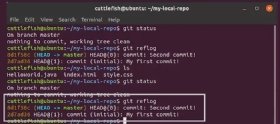

You can override the warning, by setting certain configuration variables, but it is usually not the best way to operate. On the local machine: git add remote faraway usernameremotemachine:path/to/repo git push faraway master Finally do git checkout master on the remote machine. Syntax to add a git remote git remote add REMOTE-ID REMOTE-URL By convention, the original / primary remote repo is called origin.
#GIT ADD REMOTE ON OTHER MACHINE HOW TO#
In this post, you will learn how to set up remotes for your local Git repo in three steps. Git remote makes it easy for developers to collaborate. The repository could be private, public, or on some server you control.

#GIT ADD REMOTE ON OTHER MACHINE CODE#
Modern versions of Git will give you an error when you try to do this. The first step is to add remote repos to your project. With Git remote, you can share your code to a remote repository. You are also probably pushing to the branch that is checked out (pushing master on machine2 to master on machine1). You can specify the remote repository with a URL as shown, or with a simple path to a directory in the filesystem containing a Git repository. In your specific scenario, you are pushing to a non-bare repository. The remote.uploadpack configuration variable eliminates the need for the -upload-pack= option to git fetch (and git pull) in the same way that remote.receivepack eliminates the need to specify -receive-pack= with git push. To achieve this, use the following command: git pull -all You can then run the git branch -r to verify if the remote repository has been added. Use it like this: git push machine1 master If you want to fetch remote branches and merge them with your work or modify your current work, you can use the git pull command. It is entirely possible that you can be working with a remote repository that is, in fact, on the same host. Git config /usr/local/git/bin/git-upload-pack Remote repositories can be on your local machine. You can save the git-receive-pack pathname as part of a “remote” to save typing if you plan on accessing that repository many times: git remote add machine1 config /usr/local/git/bin/git-receive-pack The pathname specified with -receive-pack= is the pathname of git-receive-pack on the remote system. You mentioned the pathname /usr/local/git/bin/git-receive-pack, so try this: git push -receive-pack=/usr/local/git/bin/git-receive-pack master If you still end up with errors like "Updates were rejected because the remote contains work that you do not have locally", this is normally because that the remote repo is recently created manually.If the remote system does not have Git in the system-default PATH (which is probably different from PATH in your login shell), then you have to tell it where to find git-receive-pack. Otherwise you will have to name local branch first by $ git branch -m Īnd then push it to add a new branch called $ git push origin -u The command to check it out is in the same format we’ve already used. git fetch -all git branch -all We can see the branch we want is in the origin remote. Push the changes in your local repository to GitHub if there is a remote branch called master (or main if that's what you're using) $ git push origin master git remote -v To see all the available branches, we need to fetch the metadata from all our remotes, then list the remote branches. In the Command prompt, add the URL for the remote repository where your local repository will be pushed. $ git commit -m "First commit"Īt the top of your GitHub repository's Quick Setup page, click to copy the remote repository URL. Ĭommit the files that you've staged in your local repository. > git clone -bare my-repo my-repo-bare.git > cd my-repo > git remote add local file:///path/to/my-repo-bare. ago You can clone the existing an existing local repo as a 'bare' repo and push and pull from the bare clone. On your laptop you can setup a local repository and push the. Just specify the local file path for the remote instead of a URL bable5 6 yr. our remote repo - which lives on GitHub, where anyone can view our files and clone or fork their own local copy. $ git initĪdd the files in your new local repository. Setup a git repository on an external hardrive and use this repository as the remote repository. Initialize the local directory as a Git repository.

Change the current working directory to your local project.


 0 kommentar(er)
0 kommentar(er)
